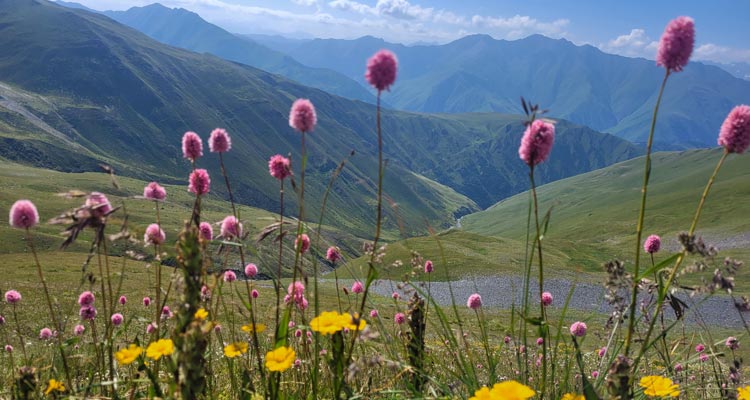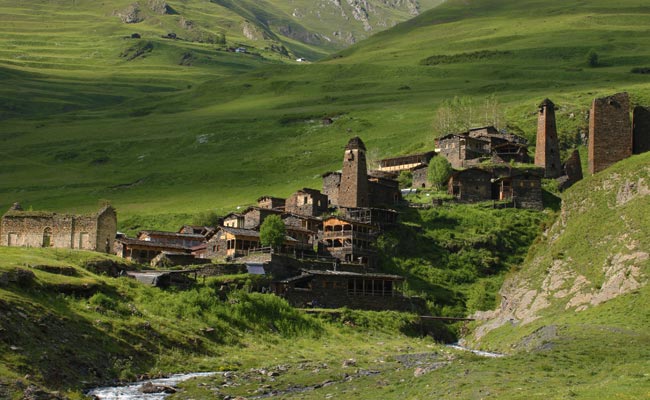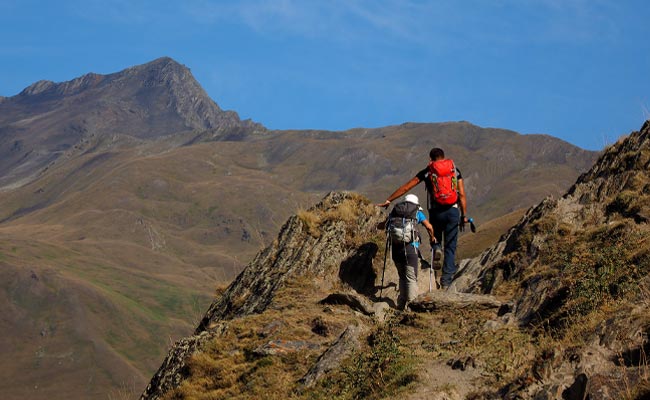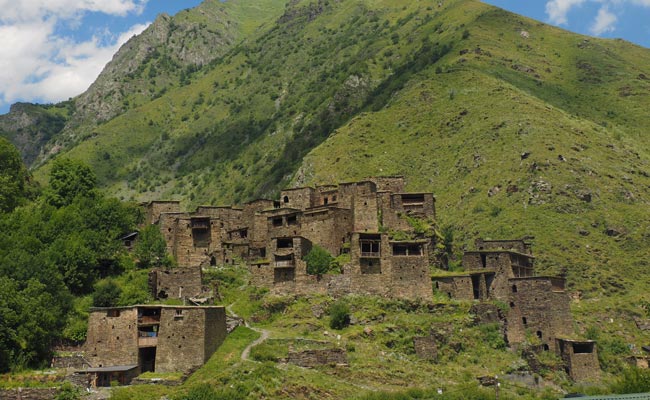|
Shatili Fortified village of Shatili is one of Georgia's absolute highlights. Its special architecture, its location in a rugged landscape and its historical and cultural background make Shatili a unique destination. General information Region: Khevsureti Shatili from Sky Here You can visit our YouTube channel and enjoy 4K footage of Shatili History of Shatili The village of Shatili with its present architecture dates from the 17th-18th centuries, but archaeological excavations have shown that a settlement existed here as early as the Bronze Age. Shatili became a fortified settlement in the 12th-13th centuries, when the lands of the North Caucasus were in a vassal relationship with the Georgian kingdom. The location of Shatili as a fortified village with the additional function of a border post is perfectly chosen. It lies a few hundred metres from Chechnya and a few kilometres from Ingushetia. The village has a natural protection on a rocky mountain, at the confluence of two rivers, the Arghuni and the Shatilis-Tskali, and very importantly, from Shatili one could control important roads, as well as border crossings from the North Caucasus and several valleys. A good protection and defence of Shatili also meant that the villages in the lower valley, but also cities such as Mtskheta and Tbilisi, were well protected, at least from this side. For these reasons, the people of Shatili were financially supported by the Georgian kings for centuries, as the landscape limited the ability to grow crops or raise livestock, and the families of Shatili were largely dependent on 'salaries' from the royal treasury. Shatili under Tsarist Russia In 1801, eastern Georgia was annexed by Tsarist Russia and the last eastern Georgian king was deposed. This did not sit well with many Georgians and there were several uprisings in the country. In 1812, during an uprising organised by Alexander, the son of King Irakli II, the rebels were defeated and retreated into the mountains, leaving Shatili as their last stronghold. The king's son Alexander spent the whole winter in Shatili, planning another attack on the tsarist army in the spring. On 13 May 1813, the Russian army joined the Georgian units in the direction of Shatili. The troops set up a base camp at Lebaiskari, from where they sent a message to Alexander offering to surrender, but the message never arrived because the boat was wrecked on the way. The decisive battle between the insurgents and the Tsarist troops took place 7 kilometres west of Shatili, in the village of Guro. The rebels fought long and bravely, but were outnumbered and defeated. The village of Guro was razed to the ground and never recovered. Shatili itself was also bombed with cannons, but it was rebuilt in the following decades. Aleksander, the king's son, fled and organised several uprisings against the Tsarist regime in Georgia. He was never caught and died in 1844 as a highly respected official in Persia. Raid on Shatili In June of 1843, Imam Shamil's troops from Dagestan invaded Shatili with 5000 fighters, whose aim was to capture the fortified village and then move further south into the valley. There were less than 100 adult men in Shatili who could pick up a weapon, but they did not want to surrender so easily. Men, women and children of Shatili fought for 3 days and succeeded in killing the leader and the Imam's right-hand man, Navab Akhverdi, and then the attackers who remained leaderless retreated. After this attack, Tsarist Russia also recognised the important role of Shatili as a border post of the country, and in recognition, Viceroy of the Caucasus Mikhail Vorontsov sent a certificate of gratitude to the inhabitants of the village. The text was carved in Georgian and Russian in a very original stone. This stone is now exhibited in the small museum of Shatili. Shatili in the 20th century during the Soviet era. At the beginning of the 20th century, the population of Shatili grew to 300 people. At that time, the whole of the Caucasus was at peace, and the people of Shatili began to build new houses in a style similar to that which had long been common in the villages of the valley, i.e. two-storey houses with lots of space and small wooden verandas. This is how the small settlement below historic Shatili came into being. In the 1950s, the Soviet power saw the need to settle the free, uncultivated areas of Georgia and began the 'planned resettlement'. During the forced resettlement, many villages in the Great Caucasus were abandoned and many were never inhabited again. Shatili was lucky enough to have a dirt road leading to the village, and the next generation of former residents began visiting their home village in the summer and rebuilding their ancestors' houses. In the 1970s there was a great deal of interest in Shatili, the gravel road was widened so that cars could easily drive through in the summer, a pioneer camp was set up a few kilometres from Shatili, and several archaeological excavations were carried out in the village itself, including the reconstruction of several fortified houses. During this period, houses were built close together on the mountain to the west of Shatili. Shatili in the present Shatili has a school, a library and a small dispensary. The defence towers are no longer used for living, but most are well maintained and some have spartan hotels and nice cafes. Unlike many villages in the mountains, Shatili has a small hydroelectric power station which supplies the village with electricity. The people of the village live either in the lower area by the river, or in the tightly packed houses to the west within a few metres of the historic part, but as Shatili is cut off from the rest of the world in winter, most of the inhabitants go down into the valley or to the towns in the autumn. In 2007, the historic fortified village of Shatili was inscribed on the UNESCO World Heritage List. Architecture and fortified houses In Shatili, there are no classical fortified towers, as in other parts of the region, but rather several fortified houses standing very close to each other, which together form a unit that is difficult to capture. In total, the historic part covers an area of one hectare and consists of around 30 fortified houses. The fortified houses of Shatili are built of river and shale stone and have 3 to 5 storeys. The first floor was for the cows, the second for the sheep, the third and fourth for the kitchen and living quarters, and the fifth for storage or shelter in case of siege. The roofs of the houses are flat and they are built in such a way that it is possible to go from the back of the village to the front, or vice versa, as the need arises. The doors of the fortified houses are positioned so that they face the doors of their neighbours, so that the entrances could be controlled or protected from each other. In the village, there was an additional house where people met and where the traditional beer "aluda" was brewed. The Shatiloba festival Every year, at the beginning of September, the Shatiloba festival is held in the village. On this day, the foundation of the village is celebrated. The traditional beer is brewed and the whole village and its guests are blessed by the village elder in a religious ritual. This is followed by a horse race and other competitions, and finally a concert with traditional dances and Georgian songs. The festival is very popular in Georgia, and it is on this day that government officials as well as ordinary citizens often come to Shatili. Transport to Shatili Public transport to Shatili is available from May to October. The minibus departs 2 times a week, Wednesdays and Saturdays at 9am from Tbilisi, Didube bus station. The trip to Shatili takes about 5 hours and costs 20 Lari per person. The bus also returns to Tbilisi twice a week, on Thursdays and Sundays. (from 2020). Roads to Shatili There is only one road to Shatili, via the Datvi-Dzvari Pass (2,677 metres), which is open from May to October. As of 2018, the road is being upgraded and when it is, the traffic here will certainly change, but it is not there yet and you will still need a four-wheel drive vehicle for this stretch. Cafes, restaurants, shops and hotels in Shatili In Shatili there are several pubs serving local food in the summer and nice cafes, especially in the historic part of the village. For those wishing to stay overnight in Shatili, there is a good choice of family hotels and simple guesthouses, most of which offer breakfast and dinner. There is a small shop in the village, but it only sells small items such as chocolates, beer, toilet paper, etc. It's a good idea to stay in the village for a few days. It would be good to know that you can only pay cash in Shatili and there are no ATMs here. Camping in Shatili There are several campsites along the river below Shatili. In addition, residents offer their gardens for camping, where you have access to drinking water and toilets. You can also order a hot meal and drink there. Hiking in Shatili Shatili is often the starting point for walks into the neighbouring region of Tusheti, and walks from Tusheti often end here. However, from Shatili you can continue your hike to Djuta and Stepantsminda. On following trip, you will visit Shatili Trekking from Omalo to Shatili >> from 990 EUR |






